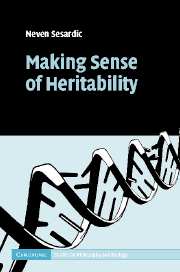Book contents
- Frontmatter
- Contents
- List of figures
- Acknowledgments
- Introduction
- 1 The nature–nurture debate: a premature burial?
- 2 A tangle of interactions: separating genetic and environmental influences
- 3 Lost in correlations? Direct and indirect genetic causes
- 4 From individuals to groups: genetics and race
- 5 Genes and malleability
- 6 Science and sensitivity
- 7 Conclusion
- References
- Index
2 - A tangle of interactions: separating genetic and environmental influences
Published online by Cambridge University Press: 22 September 2009
- Frontmatter
- Contents
- List of figures
- Acknowledgments
- Introduction
- 1 The nature–nurture debate: a premature burial?
- 2 A tangle of interactions: separating genetic and environmental influences
- 3 Lost in correlations? Direct and indirect genetic causes
- 4 From individuals to groups: genetics and race
- 5 Genes and malleability
- 6 Science and sensitivity
- 7 Conclusion
- References
- Index
Summary
No aspect of human behavior genetics has caused more confusion and generated more obscurantism than the analysis and interpretation of the various types of non-additivity and non-independence of gene and environmental action and interaction.
Lindon J. EavesTWO CONCEPTS OF INTERACTION
A widespread conviction that heritability claims are devoid of almost any interesting explanatory content is often based on an argument that genes and environments interact, and that for this reason their causal contributions to phenotype cannot be separated and measured independently. An immediate problem with this argument is that there are two very different meanings of “interaction”: commonsense and statistical. According to the commonsense notion (interactionc), to say that two causes A and B interact means that neither can produce the effect without the presence of the other. To use a standard example, striking a match and the presence of oxygen interact to produce fire. According to the statistical notion (interactions), however, to say that two variables A and B interact means that a change in one variable does not always have an effect of the same magnitude: its effect varies, depending on the value of the other variable. For instance, the very same life event, such as parental divorce, may affect children with different personality characteristics quite differently.
Already a half a century ago Waddington proposed that, in order to avoid confusion, the term “gene-environment interaction” should be reserved for the statistical concept:
This expression [gene-environment interaction] is derived from statistical terminology and, as this example makes clear, is used in a much more restricted sense than might appear at first sight. […]
- Type
- Chapter
- Information
- Making Sense of Heritability , pp. 48 - 88Publisher: Cambridge University PressPrint publication year: 2005
- 1
- Cited by



